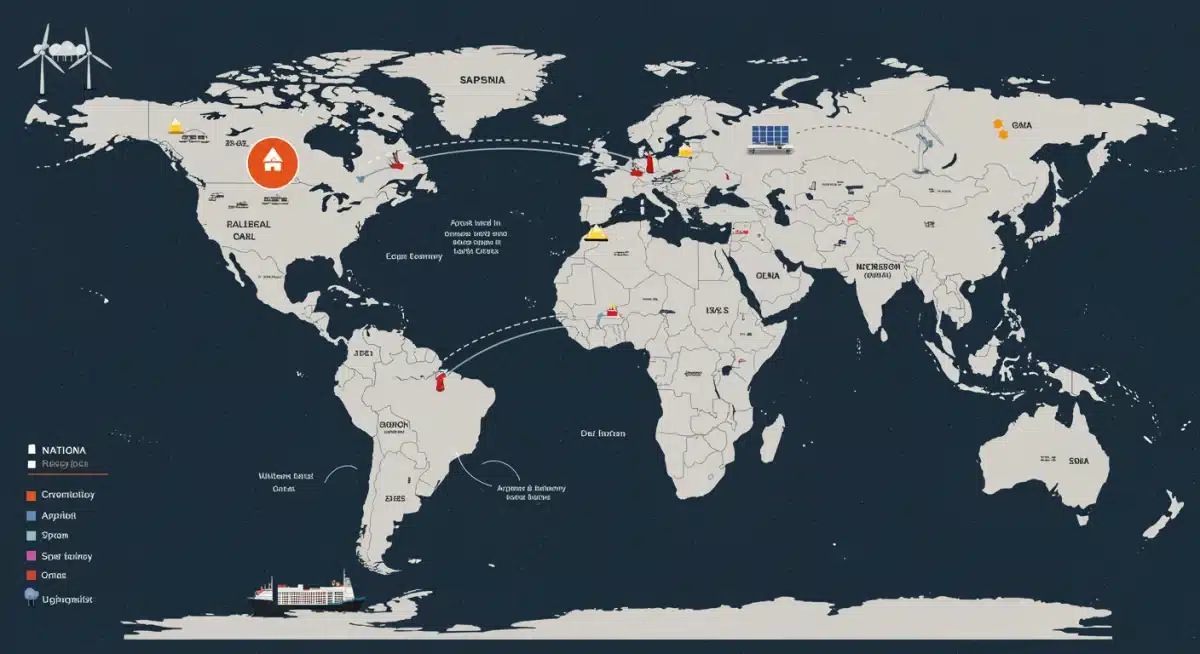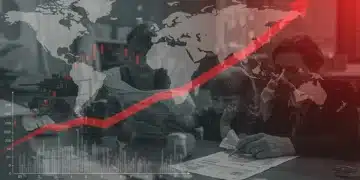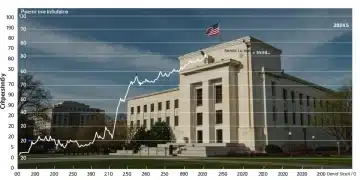1970s Energy Crisis: Lessons for 2025 Inflation & Security

The 1970s energy crisis offers critical insights into managing 2025 inflationary pressures and strengthening national energy security by underscoring the imperative for diverse energy portfolios and robust strategic reserves.
As global markets brace for potential economic shifts, the historical context of the 1970s Energy Crisis: Lessons for 2025 Inflationary Pressures and National Energy Security (INSIDER KNOWLEDGE) becomes increasingly relevant. Understanding this pivotal period provides crucial insights into navigating today’s complex energy landscape and safeguarding future economic stability.
Historical Context of the 1970s Energy Crisis
The 1970s energy crisis, primarily triggered by geopolitical events, plunged the world into an era of unprecedented economic instability. The oil embargo initiated by Arab members of OPEC in October 1973, in response to Western support for Israel during the Yom Kippur War, dramatically curtailed oil supplies and sent crude oil prices soaring. This sudden shock to the global energy system exposed vulnerabilities in nations heavily reliant on imported oil.
The immediate impact was widespread panic, marked by long queues at gas stations, rationing, and a palpable sense of uncertainty. Beyond the consumer level, industries faced severe disruptions, leading to reduced production, layoffs, and a significant slowdown in economic activity. The crisis underscored the profound link between energy availability, national security, and economic prosperity.
Geopolitical Triggers and Market Reactions
The political decisions made in the Middle East had immediate and far-reaching economic consequences globally. The coordinated action by OPEC highlighted the power of oil-producing nations to influence international markets and exert political leverage. This period demonstrated how external geopolitical factors can directly translate into domestic economic hardship, particularly through energy prices.
- OPEC Oil Embargo: Reduced oil supply by 5% globally, but perception of scarcity led to much higher price increases.
- Price Shocks: Crude oil prices quadrupled from roughly $3 to $12 per barrel, triggering rampant inflation.
- National Responses: Countries implemented various measures, including rationing, speed limits, and exploring alternative energy sources.
Economic Fallout: Inflation and Recession
The surge in oil prices acted as a massive supply shock, driving up costs across all sectors of the economy. Businesses faced higher operational expenses, which were then passed on to consumers in the form of increased prices for goods and services. This phenomenon, known as ‘stagflation’—a combination of stagnant economic growth and high inflation—became a defining characteristic of the decade.
Inflationary Pressures: 1970s vs. 2025 Outlook
Comparing the inflationary pressures of the 1970s with potential scenarios for 2025 reveals striking parallels and crucial differences. While the specific triggers may vary, the underlying mechanisms by which energy costs fuel inflation remain consistent. In the 1970s, it was a direct supply shock; in 2025, it could stem from geopolitical tensions, supply chain disruptions, or rapid increases in demand outstripping supply from an energy transition.
Current economic forecasts for 2025 suggest continued vigilance against inflation, with energy prices remaining a significant variable. Factors such as the ongoing conflict in Eastern Europe, potential disruptions in major shipping lanes, and the pace of global decarbonization efforts all contribute to an uncertain energy price outlook. These elements could collectively exert upward pressure on inflation, echoing the challenges of fifty years ago.
Energy as an Inflationary Driver
Energy is a foundational input for almost all economic activities. When its price increases, a ripple effect permeates through the entire economy, impacting everything from manufacturing and transportation to food production and consumer goods. This ‘cost-push’ inflation can be particularly stubborn to combat, as it is driven by fundamental input costs rather than just demand-side pressures.
- Transportation Costs: Higher fuel prices increase shipping costs for all goods.
- Manufacturing Expenses: Energy-intensive industries face higher production costs.
- Agricultural Impact: Increased costs for machinery, fertilizers, and transport affect food prices.
Policy Responses and Their Effectiveness
The 1970s saw various policy responses, some more effective than others. Central banks struggled to curb inflation without stifling economic growth, leading to a prolonged period of stagflation. Lessons learned from this era emphasize the need for a multi-faceted approach, combining monetary policy with strategic energy planning and fiscal measures to mitigate shocks.
National Energy Security: Lessons from the Past
The concept of national energy security gained paramount importance after the 1970s crisis. Nations realized that heavy reliance on a single energy source or a limited number of suppliers posed significant strategic risks. Diversification of energy sources and suppliers, alongside the establishment of strategic reserves, became key pillars of energy policy across developed economies.
For 2025, the challenge of national energy security is compounded by the imperative of climate change. The transition to cleaner energy sources must be managed in a way that does not compromise reliability or affordability. Balancing the need for decarbonization with the demand for consistent energy supply requires careful planning and significant investment in resilient infrastructure and diverse energy portfolios.
Diversification of Energy Sources
One of the most critical lessons was the danger of monoculture in energy supply. Post-1970s, many countries began investing in nuclear power, natural gas, and renewable energy technologies as alternatives to oil. This move aimed to reduce dependence on volatile global oil markets and enhance domestic energy resilience.
- Nuclear Power: Provided a stable, baseload power source, reducing fossil fuel reliance.
- Natural Gas: Offered a cleaner-burning fossil fuel alternative, often domestically sourced.
- Renewables: Early investments in solar and wind began, laying groundwork for future expansion.
Strategic Petroleum Reserves and International Cooperation
The creation of Strategic Petroleum Reserves (SPRs) in many countries, including the United States, was a direct response to the 1973 oil embargo. These reserves are designed to provide a buffer against sudden supply disruptions. International cooperation, such as through the International Energy Agency (IEA), also emerged as a mechanism to coordinate responses to energy crises and share information.

Policy Responses and Future Preparedness for 2025
Looking towards 2025, policymakers are drawing on the experiences of the past to formulate robust strategies against potential energy shocks and inflationary pressures. The focus is on proactive measures rather than reactive ones, emphasizing resilience, sustainability, and flexibility in energy systems. This includes accelerating the energy transition while ensuring energy supply stability.
Governments are increasingly recognizing the interconnectedness of energy, climate, and economic stability. Policies are being designed to encourage investment in renewable energy, improve energy efficiency, and strengthen grid infrastructure. The goal is to build an energy system that can withstand future disruptions, whether from geopolitical events, natural disasters, or rapid shifts in demand.
Investing in Renewable Energy and Infrastructure
A key strategy for 2025 preparedness involves substantial investment in renewable energy sources like solar, wind, and geothermal. These sources offer long-term price stability once established and reduce reliance on imported fossil fuels. Alongside this, modernization of electricity grids is crucial to integrate these new sources effectively and ensure reliable power delivery.
Enhancing Energy Efficiency and Conservation
Beyond supply-side measures, demand-side management through enhanced energy efficiency and conservation remains a powerful tool. Policies promoting energy-efficient appliances, building codes, and public awareness campaigns can significantly reduce overall energy consumption, thereby lessening vulnerability to price spikes and supply interruptions.
- Building Standards: Stricter regulations for new construction and retrofits to minimize energy waste.
- Smart Grid Technologies: Optimizing energy distribution and consumption in real-time.
- Consumer Incentives: Rebates and tax credits for adopting energy-efficient technologies.
Global Interdependencies and Geopolitical Risks
The world of 2025 is arguably more interconnected than the 1970s, meaning energy shocks in one region can have rapid and widespread global ramifications. Geopolitical risks, including regional conflicts, trade disputes, and cyber threats to critical infrastructure, pose constant threats to energy supply chains. Maintaining diversified international partnerships and robust diplomatic channels is essential.
The shift towards new energy technologies also introduces new interdependencies, particularly concerning critical minerals required for batteries and renewable energy components. Securing these supply chains and avoiding over-reliance on any single nation for these vital resources is a growing challenge for national energy security.
Supply Chain Vulnerabilities
Modern supply chains, while efficient, can be fragile. A single disruption at a key chokepoint or in the extraction of a critical mineral can cascade through the entire system. Understanding and mitigating these vulnerabilities is a priority for ensuring stable energy transitions and preventing future inflationary pressures linked to resource scarcity.
The Role of International Cooperation
No single nation can fully insulate itself from global energy market dynamics. International cooperation through organizations like the IEA, G7, and G20, as well as bilateral agreements, remains crucial. These platforms facilitate information sharing, coordinated policy responses, and collective action to stabilize markets during times of crisis, drawing directly from lessons learned during the 1970s Energy Crisis: Lessons for 2025 Inflationary Pressures and National Energy Security (INSIDER KNOWLEDGE).
The Path Forward: Building Resilient Energy Systems
Building resilient energy systems for 2025 and beyond requires a comprehensive approach that integrates technological innovation, sound economic policies, and proactive risk management. The lessons from the 1970s emphasize that complacency in energy policy can lead to severe economic consequences. Continuous adaptation and foresight are paramount in a rapidly evolving global energy landscape.
This path forward involves not only investing in new energy sources but also ensuring the reliability of existing infrastructure, fostering innovation in energy storage, and developing flexible grids that can adapt to varying supply and demand. Education and public engagement also play a role in promoting energy conservation and supporting the transition to a more sustainable and secure energy future.
Technological Advancements and Innovation
Emerging technologies, such as advanced battery storage, smart grids, and next-generation nuclear reactors, offer promising solutions for enhancing energy resilience. Continued research and development in these areas are critical to unlocking new possibilities for energy independence and reducing vulnerability to external shocks.
Strategic Planning and Risk Management
Effective strategic planning involves anticipating future energy needs and potential risks. This includes regular stress tests of energy systems, developing contingency plans for various disruption scenarios, and maintaining adequate strategic reserves of both traditional and new energy carriers. A proactive risk management framework is essential for mitigating the impact of unforeseen events on national energy security and economic stability.
| Key Point | Brief Description |
|---|---|
| 1970s Oil Shock | Geopolitical events led to a sudden quadrupling of oil prices, causing severe global stagflation. |
| Inflationary Parallels | Energy costs remain a primary driver of inflation; 2025 faces potential shocks from geopolitics and supply chain issues. |
| Energy Security | Lessons emphasize diversification, strategic reserves, and international cooperation to mitigate supply risks. |
| 2025 Preparedness | Focus on renewable investment, efficiency, and robust risk management for a resilient energy future. |
Frequently Asked Questions About Energy Crises
The 1970s energy crisis was primarily caused by the 1973 oil embargo imposed by Arab OPEC members against countries supporting Israel during the Yom Kippur War. This significantly reduced global oil supply, leading to a sharp increase in prices and widespread economic disruption.
Both periods highlight energy’s role as a major inflationary driver. In the 1970s, it was a supply shock. For 2025, geopolitical tensions, supply chain vulnerabilities, and energy transition costs could similarly push up energy prices, fueling broader inflation.
National energy security refers to a nation’s ability to ensure a reliable, affordable, and sustainable supply of energy for its citizens and economy. It involves diversifying sources, maintaining strategic reserves, and protecting energy infrastructure from threats.
Countries learned the critical importance of diversifying energy sources beyond oil, investing in domestic production, developing strategic reserves, and fostering international cooperation to stabilize markets and respond to future supply disruptions effectively.
Current preparedness for 2025 includes accelerating investment in renewable energy, enhancing energy efficiency, modernizing grid infrastructure, and strengthening international partnerships to mitigate geopolitical risks and secure critical mineral supply chains for new technologies.
Looking Ahead: Navigating Future Energy Challenges
As the global community moves towards 2025, the insights gleaned from the 1970s energy crisis serve as a stark reminder of the intrinsic link between energy, economics, and national stability. Policymakers and industry leaders are actively working to build more resilient and diversified energy systems. The ongoing developments in renewable energy technology, coupled with strategic investments in energy infrastructure and international diplomacy, are crucial in mitigating future inflationary pressures and bolstering national energy security against an ever-evolving geopolitical landscape. Vigilance and proactive adaptation remain key to navigating the complexities of the modern energy world.





